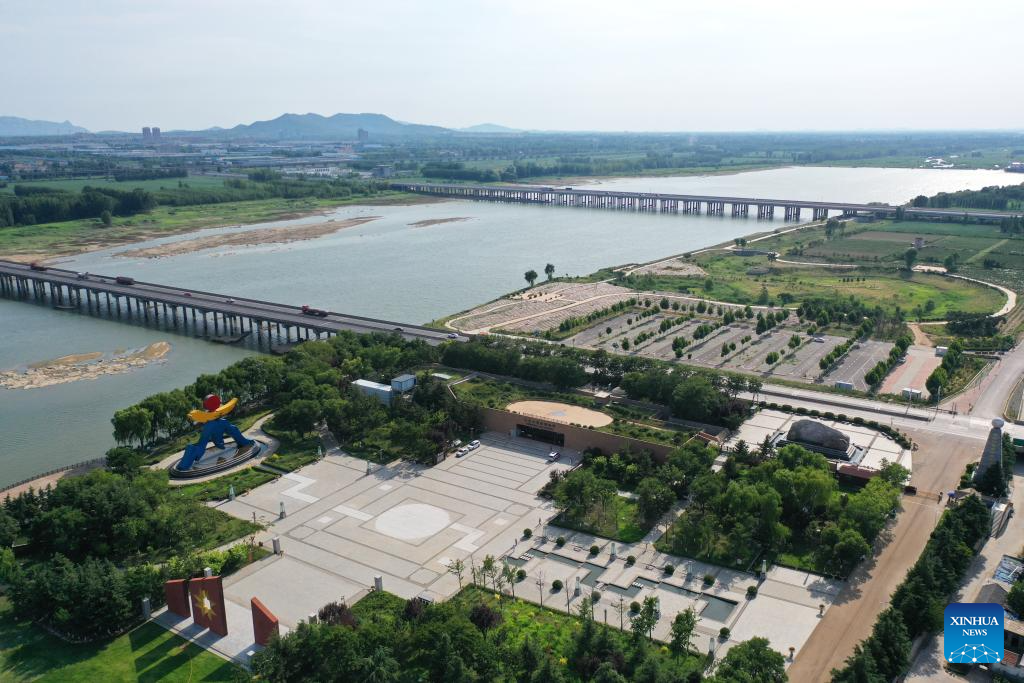Step Back in Time: The Significance of Dawenkou Ruins in Chinese History

An Essential Guide to Visiting Dawenkou Ruins
In This Guide
- An Essential Guide to Visiting Dawenkou Ruins
- The Rich History and Legends of Dawenkou Ruins
- Main Highlights: What You Absolutely Can’t Miss
- Planning Your Visit: A Practical Guide
- Tickets: Prices, Booking, and Tips
- How to Get There: A Complete Transportation Guide
- Local Cuisine and Accommodation Nearby
- Frequently Asked Questions
- Final Thoughts on Your Trip
Discovering the Dawenkou Ruins: A Journey into Neolithic China
Nestled in the picturesque region of Tai’an, Shandong Province, the Dawenkou Ruins (大汶口遗址) offer an intriguing glimpse into the Neolithic era of Chinese history, dating back over 7,000 years. This archaeological site is not just a destination for the casual traveler; it beckons to history enthusiasts, archaeologists, and those keen to understand the roots of Chinese civilization. As you explore the remnants of this ancient settlement, you’ll encounter an impressive array of artifacts, including pottery and stone tools, which reveal the daily lives and cultural practices of its early inhabitants.
While the site itself is currently undergoing excavation, the nearby Dawenkou Museum houses replicas of significant finds, providing context and showcasing the artistry of the era. Though the museum may be small and somewhat rustic, it serves as a vital portal to the past, offering insights into the agricultural practices and architectural innovations of the Dawenkou culture.
Whether you’re a dedicated archaeologist or a curious traveler, visiting the Dawenkou Ruins promises a unique adventure steeped in history. The journey to this ancient site not only enriches your understanding of China’s Neolithic past but also allows you to experience the tranquil beauty of Shandong’s countryside. Here’s everything you need to know to make the most of your visit to this remarkable archaeological treasure.

Dawenkou Ruins.
The Rich History and Legends of Dawenkou Ruins
Nestled in the heart of Shandong Province, the Dawenkou Ruins are a treasure trove of Neolithic history, offering a captivating glimpse into the lives of ancient Chinese civilizations. Dating back approximately 7,000 years, this archaeological site is not only significant for its age but also for the wealth of artifacts it has yielded, shedding light on the social, cultural, and agricultural practices of the people who once inhabited the region.
The Dawn of Civilization
The Dawenkou culture, named after the site itself, emerged during the late Neolithic period (about 4500 to 2500 BCE). It is characterized by its distinctive pottery, which showcases intricate designs and advanced techniques that were quite sophisticated for their time. Archaeologists have unearthed an impressive array of artifacts including beautifully crafted pottery, stone tools, and even remnants of dwellings, which provide insight into the architectural styles and living conditions of the era.
The site is strategically located near the Yellow River, which was crucial for agriculture and trade. This proximity to water sources allowed the inhabitants to cultivate crops, particularly millet, and engage in fishing, which were essential for their sustenance. The discovery of various farming tools indicates the community’s reliance on agriculture, marking a significant transition from nomadic lifestyles to settled farming.

Dawenkou Ruins.
Legends and Lore
While the Dawenkou Ruins may not be steeped in the same mythological narratives as the more famous sites in China, local folklore has woven its own tapestry of legends around the area. One prominent tale speaks of the “River Spirit” who once protected the villagers. According to the legend, this spirit would bless the fields with fertility and ensure abundant harvests. However, it was said that the spirit demanded respect and offerings, and any neglect would bring misfortune, leading to droughts or failed crops.
Another story involves the discovery of the ancient pottery itself. It is said that a wandering scholar stumbled upon the ruins while searching for wisdom and knowledge. Enchanted by the shards of pottery, he believed they held the whispers of the ancestors. He collected these pieces and, through meditation, claims to have communicated with the spirits of the past, who imparted ancient agricultural techniques and philosophies that would benefit the generations to come.

Dawenkou Ruins.
A Legacy Unearthed
The archaeological significance of the Dawenkou site extends beyond its artifacts; it serves as a pivotal point in understanding the development of early Chinese society. The original pottery and tools discovered here are now housed in the Shandong Provincial Museum in Jinan, where they continue to fascinate visitors and scholars alike.
Today, Dawenkou remains a site of ongoing excavation, and while it may not boast the grandeur of more prominent historical attractions, it holds a unique charm for those intrigued by the roots of civilization. The small museum in the nearby town offers replicas of the artifacts, providing a tangible connection to this ancient culture, albeit with limited English signage and resources.
Visiting Dawenkou
For international travelers with a passion for history and culture, a visit to Dawenkou offers an opportunity to walk in the footsteps of the ancient inhabitants of Shandong. While the site is approximately two hours from Jinan, it is well worth the journey for those eager to explore the rich tapestry of China’s Neolithic past. As the ruins continue to reveal their secrets, they invite all who come to reflect on the enduring legacy of human ingenuity and resilience.

Dawenkou Ruins.
Main Highlights: What You Absolutely Can’t Miss
Discover the Rich History of the Dawenkou Ruins
The Dawenkou Ruins, located in Tai’an, Shandong Province, offer a fascinating glimpse into the Neolithic era of Chinese history. This archaeological site, dating back approximately 7,000 years, is part of the Dawenkou culture, known for its advanced pottery and agricultural practices. Here are the main highlights you absolutely cannot miss during your visit:
1. The Archaeological Site
- Excavation Insights: Walk around the site where ongoing excavations reveal the foundations of ancient dwellings. While it may appear abandoned, the location’s significance lies in its historical context—understanding how early agricultural societies lived and thrived.
- Cultural Landscape: The site’s proximity to the river reflects the importance of water resources in the establishment of early communities. Observing the layout can provide insights into their agricultural practices and relationship with the environment.
2. Dawenkou Museum
- Pottery Replicas: Across from the main site, the small local museum houses replicas of the exquisite pottery that once adorned the homes of Dawenkou inhabitants. Though modest, the museum serves as a complement to your exploration of the ruins.
- Artifact Displays: Although the museum is small and currently features minimal signage, visitors can view stone tools and grinders used by the ancient people. Keep an eye out for plans of expansion, which promise to enhance the visitor experience in the near future.

Dawenkou Ruins.
3. Original Pottery Collection
- Shandong Provincial Museum: For a deeper understanding of the Dawenkou culture, plan a trip to the Shandong Provincial Museum in Jinan, where original artifacts, including pottery and tools, are preserved. This visit will provide context and a connection to the objects you see at the site and in the museum.
4. Nearby Attractions
- Mount Tai: A UNESCO World Heritage site, Mount Tai is located just a short drive away. This sacred mountain offers breathtaking views and a chance to hike through ancient temples and natural beauty, enriching your historical journey in the region.
- Cultural Experiences: Explore the nearby ancient magnetic kiln site and other archaeological wonders that complement the story of the Dawenkou culture. These sites are less crowded and offer a serene atmosphere for reflection.
5. Travel Tips
- Guided Tours: Consider hiring a local guide who can provide detailed translations and insights, especially within the museum, where English resources may be limited. This will greatly enhance your understanding of the site’s significance.
- Timing Your Visit: Dawenkou is about a two-hour drive from Jinan. To make the most of your trip, plan to visit early in the day when the site is less crowded and cooler for exploration.

Dawenkou Ruins.
Conclusion
The Dawenkou Ruins are a must-visit for anyone interested in the depths of Chinese history and culture. With its archaeological significance and the intimate look at ancient life, this site provides a profound connection to the past. Don’t forget your camera—there’s a wealth of history waiting to be captured!
Planning Your Visit: A Practical Guide
Essential Information for Your Trip to the Dawenkou Ruins
Embarking on a journey to the Dawenkou Ruins (大汶口遗址) offers a unique glimpse into China’s Neolithic past. Nestled in Dawenkou Town, located in Tai’an, Shandong Province, this archaeological site is a treasure trove for history enthusiasts and cultural explorers alike. Here’s a practical guide to help you plan your visit.

Dawenkou Ruins.
Getting There
- Location: Dawenkou Town, Daiyue District, Tai’an 271026, China.
- Distance: Approximately 2 hours by car from Jinan, the provincial capital of Shandong.
- Transport: The most convenient way to reach the site is by taxi or private car. Public transport options might be limited, so consider hiring a guide or joining a local tour group for a more informative experience.
Opening Hours
- Museum Hours:
- Friday to Thursday: 7:55 AM – 6:00 PM
- Closed on Holidays: Always check local listings for any changes in schedule.

Dawenkou Ruins.
What to Expect
-
The Site: The Dawenkou Ruins are primarily known for their archaeological significance, showcasing relics from a civilization that thrived around 7000 years ago. Currently, the excavation site may appear somewhat abandoned, but it provides crucial insights into early agricultural practices, housing structures, and pottery styles of the time.
-
The Museum: The small museum across the street houses replicas of pottery and other artifacts discovered at the site. While the museum is expected to expand, it currently offers a modest but intriguing collection. Be prepared for minimal English signage and limited guidance from staff.
Tips for Your Visit
-
Bring a Guide: Given the language barrier and the limited information available on-site, hiring a local guide who can translate and provide context about the ruins will significantly enhance your experience.
-
Photography: The site and museum are picturesque, making for excellent photographs. Ensure you have your camera ready, but be respectful of any restrictions regarding photography in certain areas.
-
Plan for Nearby Attractions: If time permits, consider exploring other nearby attractions such as:
- Mount Tai: A UNESCO World Heritage site known for its stunning scenery and cultural significance.
- Daimiao Temple: Renowned for its ancient architecture and spiritual importance.

Dawenkou Ruins.
Accommodation
While there are no hotels directly in Dawenkou Town, you can find a variety of accommodations in nearby Tai’an. Options range from budget hostels to luxury hotels, catering to different preferences and budgets. Some recommended hotels in Tai’an include:
- Luke 88 Hotels
- Wyndham Hotels
- GreenTree Inns
Dining Options
Dining options in Dawenkou are limited, but you can find local eateries in Tai’an that serve authentic Shandong cuisine. Be sure to sample local specialties like Jinan-style dumplings and sweet and sour carp.

Dawenkou Ruins.
Final Thoughts
Visiting the Dawenkou Ruins is a journey into the depths of ancient Chinese civilization. While the site may not be as polished as more famous tourist attractions, it offers a profound connection to the past for those willing to explore. Embrace the adventure, and let the whispers of history guide your exploration.
Tickets: Prices, Booking, and Tips
Exploring the Dawenkou Ruins: Ticket Information and Travel Tips
Visiting the Dawenkou Ruins offers a unique glimpse into China’s Neolithic past, making it a fascinating destination for history enthusiasts. Here’s what you need to know about tickets, booking, and maximizing your experience.
Ticket Prices
- General Admission: The entry fee for the Dawenkou Ruins is approximately 30 CNY (around $5 USD). This fee grants access to the site and the small museum nearby that showcases replicas of pottery and artifacts from the excavation.
- Discounted Rates: Students and seniors may be eligible for discounted tickets, so be sure to bring relevant identification.
- Museum Access: While the museum is included in the ticket price, it is worth noting that it is relatively small and may not be extensively staffed.

Dawenkou Ruins.
Booking Information
- Advance Booking: Currently, there is no requirement for advance booking. Visitors can purchase tickets on-site. However, it’s advisable to check for any updates on booking policies if you’re planning to visit during peak tourist seasons.
- Guided Tours: For a richer experience, consider hiring a local guide who can provide insights into the archaeological significance of the site. There are various tour options available, including private and group tours, often bookable through travel platforms.
Visiting Hours
- The Dawenkou site is open to visitors daily from 7:55 AM to 6:00 PM. It’s best to arrive early to avoid crowds and enjoy a quieter exploration of the ruins.

Dawenkou Ruins.
Tips for Your Visit
- Bring a Guidebook: With minimal signage in English, a guidebook or a translation app can enhance your understanding of the site and its historical context.
- Plan for Transportation: The Dawenkou Ruins are located about two hours from Jinan by car. Renting a vehicle or arranging for a driver is recommended to facilitate your visit. Public transport options may be limited.
- Combine with Nearby Attractions: Consider visiting other historical sites in the Tai’an area, such as the Ancient Magnetic Kiln Site or Mount Tai, to make the most of your trip.
- Be Mindful of Weather: The area experiences a range of weather conditions, so check the forecast and dress accordingly for a comfortable visit.
Conclusion
The Dawenkou Ruins present an intriguing opportunity to delve into ancient Chinese culture. With a modest entry fee and the chance to see artifacts dating back 7,000 years, it is a must-visit for those passionate about history. Prepare well, and your journey to this archaeological treasure will surely be rewarding.
How to Get There: A Complete Transportation Guide
Navigating Your Way to Dawenkou Ruins
Visiting the Dawenkou Ruins (大汶口遗址) is an exciting journey into the heart of China’s Neolithic history. Located in Dawenkou Town, within the Daiyue District of Tai’an, Shandong Province, this archaeological site provides a fascinating glimpse into ancient civilization. However, getting there can be a bit tricky for international travelers, so here’s a comprehensive guide to help you navigate your way to this historical gem.
Arrival by Air
1. Fly into Jinan Yaochang Airport (TNA)
The closest major airport to Dawenkou is Jinan Yaochang Airport, located approximately 120 kilometers (about 75 miles) from the site. Various airlines operate flights to Jinan from major cities in China and select international locations.
2. Alternative Airport – Qingdao Liuting International Airport (TAO)
If Jinan Yaochang is not an option, consider flying into Qingdao Liuting International Airport. It is approximately 400 kilometers (about 250 miles) away but offers a broader range of international flights.
Ground Transportation Options
1. From Jinan Yaochang Airport to Dawenkou
– Car Rental: The most convenient option is to rent a car at the airport. The drive to Dawenkou takes about 2 hours. Ensure you have a GPS or a reliable map app, as road signs in rural areas may not always be in English.
– Taxi or Ride-Sharing: Taxis are available at the airport. It’s advisable to confirm the fare beforehand or use a ride-sharing app if available.
– Airport Shuttle or Private Transfer: Some hotels in Tai’an may offer shuttle services. Booking a private transfer in advance can ensure a smoother journey.
2. From Jinan City to Dawenkou
If you are already in Jinan, you can take the following options:
– Bus: There are regular bus services from Jinan to Tai’an. Once in Tai’an, you can take a local taxi to Dawenkou, which is about 30 kilometers (18 miles) away.
– Train: High-speed trains run frequently from Jinan to Tai’an and take about 30 minutes. Upon arrival at Tai’an Railway Station, taxis are readily available for the short ride to Dawenkou.
Local Transportation in Dawenkou
1. Taxis and Local Buses
Once you arrive in Dawenkou, taxis are the most straightforward way to reach the site and the nearby museum, which is just a short distance away. Local buses may also be available, but they may not have English signage, so having your destination written in Chinese can be helpful.
2. Walking
For those who enjoy a leisurely stroll, the site is accessible on foot from the village center. The walk offers a chance to absorb the local atmosphere and scenery.
Tips for a Smooth Journey
- Language Barrier: English is not widely spoken in this rural area. Consider hiring a local guide or using translation apps to facilitate communication.
- Timing Your Visit: The site is open daily from 7:55 AM to 6:00 PM. Plan your visit accordingly to ensure you have ample time to explore the ruins and the museum.
- Weather Considerations: Check the weather forecast before your trip. The best time to visit is during spring (April to June) and autumn (September to October) when the weather is mild.
Conclusion
Embarking on a journey to the Dawenkou Ruins is not just about reaching a destination; it’s about immersing yourself in the rich tapestry of Chinese history. With this transportation guide, you’re well-prepared to navigate your way to this archaeological wonder. Enjoy your adventure into the past!
Local Cuisine and Accommodation Nearby
When visiting the Dawenkou Ruins, immersing yourself in the local culture extends beyond the archaeological site itself. The area offers a delightful array of regional cuisine and comfortable accommodations that cater to international travelers eager to explore the rich historical tapestry of Shandong.
Culinary Delights
Local Specialties:
1. Jinan-style Grilled Fish (煎鱼) – A must-try dish, this succulent fish is grilled to perfection, often served with a delicious blend of spices that highlight the freshness of the catch.
2. Dumplings (饺子) – Shandong is renowned for its dumplings, which are filled with a variety of ingredients, from pork and chives to shrimp and vegetables. Look for local eateries that serve handmade dumplings for an authentic experience.
3. Tofu Dishes (豆腐菜) – The region is famous for its tofu, which is often prepared in various styles, including stir-fried, stewed, or in soups.
4. Braised Pork (红烧肉) – Tender and flavorful, this dish showcases the culinary artistry of Shandong with its rich sauce and meltingly soft meat.
Recommended Dining Spots:
– Dawenkou Restaurant (大汶口饭店): Located near the ruins, this restaurant offers a cozy atmosphere and a menu full of local delicacies, perfect for refueling after a day of exploration.
– Tai’an Old Street Food Vendors: Just a short drive from the site, this bustling street offers various food stalls where you can sample traditional snacks and dishes, providing a genuine taste of local life.
Comfortable Stays
When it comes to accommodation, you’ll find a range of options that cater to different preferences and budgets. Here are some recommendations:
- Luke 88 Hotel (鲁客88酒店) – A modern hotel that offers comfortable rooms and amenities, perfect for travelers seeking convenience and style. Located close to the city center, it provides easy access to various attractions.
- Wyndham Tai’an (温德姆大酒店) – This upscale hotel features luxurious accommodations and excellent dining options, ideal for those looking for a more refined experience. Its location makes it easy to explore both the Dawenkou Ruins and the majestic Mount Tai.
- HanTing Express (汉庭酒店) – A budget-friendly option with clean, basic rooms. This chain hotel provides reliable service and is a good choice for travelers who prioritize value without sacrificing comfort.
Pro Tips
- Timing Your Visit: It’s advisable to visit the Dawenkou site in the morning to avoid the midday heat, making your dining experience afterward even more enjoyable.
- Language Barrier: While many locals may not speak English, don’t hesitate to use translation apps or phrasebooks to enhance your dining experience and communicate your culinary preferences.
By indulging in local flavors and enjoying comfortable accommodations, you can deepen your understanding of Shandong’s rich culture while marveling at the ancient wonders of the Dawenkou Ruins.
Frequently Asked Questions
Frequently Asked Questions about Dawenkou Ruins
1. What are the Dawenkou Ruins?
The Dawenkou Ruins are an important archaeological site located in Tai’an, Shandong Province, China. Dating back to the Neolithic period (approximately 4500 to 2500 BCE), these ruins provide significant insights into early Chinese civilization, showcasing the pottery, tools, and settlement patterns of ancient communities.
2. How do I get to the Dawenkou Ruins?
The site is approximately a two-hour drive from Jinan, the capital of Shandong Province. Visitors can hire a taxi or join a guided tour for convenience. Public transport options may be limited, so planning ahead is advisable.
3. Is there an entrance fee?
There is currently no standardized entry fee for visiting the Dawenkou Ruins. However, it is advisable to check for any changes or updates before your visit.
4. What can I see at the Dawenkou Ruins?
Visitors can explore the excavation site where various artifacts, such as pottery and stone tools, have been uncovered. A small museum in Dawenkou town displays replicas of these artifacts, although it may be modest in size and resources.
5. Are there guided tours available?
While there are no official guided tours directly at the site, hiring a local guide can enhance your experience, especially if you are interested in the archaeological significance of the area. Many travelers recommend finding a guide who can translate and provide context during your visit.
6. What should I expect in terms of facilities?
Facilities at the site are basic. The museum is small and may not have extensive English signage. Visitors should be prepared for a more rustic experience, including minimal amenities and potential language barriers.
7. How long should I plan to spend at the site?
A visit to the Dawenkou Ruins typically requires about 1-2 hours, depending on your level of interest in archaeology and history. If you are keen on exploring the surrounding area or visiting nearby attractions, consider allocating more time.
8. What is nearby that I can also visit?
While in the region, consider visiting the Ancient Magnetic Kiln Site or Mount Tai, a UNESCO World Heritage Site known for its stunning scenery and rich cultural history. These attractions can provide a fuller experience of Shandong Province’s historical and natural offerings.
Final Thoughts on Your Trip
As you prepare to conclude your journey through the rich tapestry of Chinese history and culture, a visit to the Dawenkou Ruins offers a unique glimpse into the Neolithic past that shaped this region. While the site may not boast the grandeur of other archaeological attractions, it embodies the enduring spirit of discovery and the connection to ancient lives that once thrived here.
Reflecting on Your Experience:
-
A Journey Through Time: Standing amidst the remnants of a civilization that flourished over 7,000 years ago, you’ll find yourself contemplating the agricultural practices, architectural innovations, and artistry of the Dawenkou people. This is where history breathes, and each fragment tells a story.
-
Understanding the Cultural Heritage: The modest museum nearby houses replicas of pottery and tools, serving as a reminder of the ingenuity of our ancestors. While the current facility may be small and somewhat rustic, it is a testament to the ongoing efforts to preserve and understand this vital piece of Chinese heritage.
-
Engagement with the Local Context: Interacting with local guides, even if language barriers exist, can enrich your visit. Their insights into the ongoing excavations and the historical significance of the area add layers of depth to your understanding.
-
A Step Off the Beaten Path: For those passionate about archaeology and history, Dawenkou is a hidden gem. It may not be a mainstream tourist destination, but for the intrepid traveler, it offers the allure of exploration and the satisfaction of connecting with ancient roots.
As you leave Dawenkou, carry with you the stories of the past and the knowledge that every corner of this vast nation holds remnants of its glorious history. From the tranquil fields where the Dawenkou people once cultivated their crops to the artifacts that now reside in museums, your journey through time continues to enrich your understanding of China. Whether you’re a history buff, a cultural enthusiast, or simply a curious wanderer, the echoes of Dawenkou will resonate with you long after your visit. Safe travels on your next adventure!